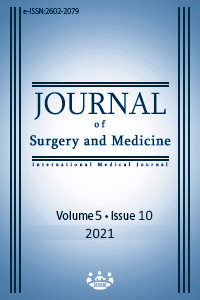Predictors of poor outcome in mushroom poisoning: A retrospective cohort study
Keywords:
Mushroom poisoning, Emergency department, Amanita Phalloides, PrognosisAbstract
Background/Aim: Mushroom poisoning (MP) can result in a wide range of clinical presentations from mild gastrointestinal complaints to hepatic necrosis or acute liver failure (ALF) requiring liver transplantation (LT). Although several predictive parameters were studied, a guideline based on a consensus is still lacking. This study aimed to investigate the parameters associated with LT-free survival in patients admitted to the emergency department with MP. Methods: This retrospective cohort study was conducted on 420 adult patients admitted to the emergency department with symptoms of MP after ingestion of mushrooms. Patients with viral hepatitis, autoimmune liver disease, acetaminophen or salicylate toxicity, or other chronic liver diseases were excluded. Favorable outcome was defined as LT-free survival while adverse outcome was defined as death or LT. Liver transaminase levels, treatment modalities, and outcomes were analyzed. Results: The median age of the patients was 46.9 (31-60) years and 59.8% were female. The season with the most MP admissions was autumn (57.6%). The latent periods of 337 (80.3%) patients were between 0-6 hours, and of 83 (19.8%), longer than 6 hours. Among them, 227 (54.0%) patients were treated with gastric lavage, 272 (64.8%), with activated charcoal, 27 (6.4%) with conventional therapy (CT) and 2 (0.5%) with hemodialysis. All 420 patients received supportive therapy (ST). Patients who received CT had higher mean AST and ALT levels than patients who received only decontamination or ST (P<0.001). One hundred and sixty-two (38.6%) patients refused further treatment while under observation. Among patients who received CT+ST, patients with adverse outcomes (liver transplant or death) had higher transaminase levels (AST: P=0.009, and ALT: P=0.008) and higher coagulation parameters (PTT: P=0.016, INR: P=0.009). Conclusion: The duration of the latent period, AST, ALT, PTT, and INR may be used as predictors of poor outcome.
Downloads
References
Bonacini M, Shetler K, Yu I, et al. Features of Patients With Severe Hepatitis Due to Mushroom Poisoning and Factors Associated With Outcome. Clinical Gastroenterology and Hepatology. 2017;15:776–9. doi: 10.1016/j.cgh.2016.11.039
Wennig R, Eyer F, Schaper A, et al. Mushroom Poisoning. Deutsches Arzteblatt International. 2020;117:701–8. doi: 10.3238/arztebl.2020.0701
Jaeger A, Jehl F, Flesch F, et al. Kinetics of amatoxins in human poisoning: therapeutic implications. Journal of toxicology Clinical toxicology. 1993;31:63–80. doi: 10.3109/15563659309000374
Trabulus S, Altiparmak MR. Clinical features and outcome of patients with amatoxin-containing mushroom poisoning. Clinical Toxicology. 2011;49:303–10. doi: 10.3109/15563650.2011.565772
Escudié L, Francoz C, Vinel JP, et al. Amanita phalloides poisoning: Reassessment of prognostic factors and indications for emergency liver transplantation. Journal of Hepatology. 2007;46:466–73. doi: 10.1016/j.jhep.2006.10.013
Kim T, Lee D, Lee JH, et al. Predictors of poor outcomes in patients with wild mushroom-induced acute liver injury. World Journal of Gastroenterology. 2017;23:1262–7. doi: 10.3748/wjg.v23.i7.1262
Ye Y, Liu Z. Management of Amanita phalloides poisoning: A literature review and update. Journal of Critical Care. 2018;46:17–22. doi: 10.1016/j.jcrc.2018.03.028
Diaz JH. Amatoxin-Containing Mushroom Poisonings: Species, Toxidromes, Treatments, and Outcomes. Wilderness and Environmental Medicine 2018;29:111–8. doi: 10.1016/j.wem.2017.10.002
Enjalbert F, Rapior S, Nouguier-Soulé J, et al. Treatment of amatoxin poisoning: 20-year retrospective analysis. Journal of toxicology Clinical toxicology. 2002;40:715–57. doi: 10.1081/clt-120014646
Yildiz BD, Abbasoglu O, Saglam A, et al. Urgent liver transplantation for Amanita phalloides poisoning. Pediatric Transplantation. 2008;12:105–8. doi: 10.1111/j.1399-3046.2007.00838.x
Ferreira R, Romãozinho JM, Amaro P, et al. Assessment of emergency liver transplantation criteria in acute liver failure due to Amanita phalloides. European Journal of Gastroenterology and Hepatology. 2011;23:1226–32. doi: 10.1097/MEG.0b013e32834c7b8f
Ganzert M, Felgenhauer N, Zilker T. Indication of liver transplantation following amatoxin intoxication. Journal of Hepatology. 2005;42:202–9. doi: 10.1016/j.jhep.2004.10.023
Ye Y, Liu Z, Zhao M. CLIF-OF >9 predicts poor outcome in patients with Amanita phalloides poisoning. American Journal of Emergency Medicine. 2021;39:96–101. doi: 10.1016/j.ajem.2020.01.027
Yardan T, Baydin A, Eden AO, et al. Wild mushroom poisonings in the Middle Black Sea region in Turkey: Analyses of 6 years. Human and Experimental Toxicology. 2010;29:767–71. doi: 10.1177/0960327110361758
Keller SA, Klukowska-Rötzler J, Schenk-Jaeger KM, et al. Mushroom poisoning—a 17 year retrospective study at a level I university emergency department in Switzerland. International Journal of Environmental Research and Public Health. 2018;15. doi: 10.3390/ijerph15122855
Colak S, Kandis H, Afacan MA, et al. Assessment of patients who presented to the emergency department with mushroom poisoning. Human and Experimental Toxicology 2015;34:725–31. doi: 10.1177/0960327114557902
Ahishali E, Boynuegri B, Ozpolat E, et al. Approach to mushroom intoxication and treatment: Can we decrease mortality? Clinics and Research in Hepatology and Gastroenterology 2012;36:139–45. doi: 10.1016/j.clinre.2011.11.004
White J, Weinstein SA, de Haro L, et al. Mushroom poisoning: A proposed new clinical classification. Toxicon. 2019;157:53–65. doi: 10.1016/j.toxicon.2018.11.007
Persson HE, Sjoberg GK, Haines JA, et al. Poisoning Severity Score. Clinical Toxicology. 1998;6:205–13.
Brandenburg WE, Ward KJ. Mushroom poisoning epidemiology in the united states. Mycologia. 2018;110:637–41. doi: 10.1080/00275514.2018.1479561.
Downloads
- 510 569
Published
Issue
Section
How to Cite
License
Copyright (c) 2021 Mehmet Altuntaş, Latif Duran
This work is licensed under a Creative Commons Attribution-NonCommercial-NoDerivatives 4.0 International License.
















